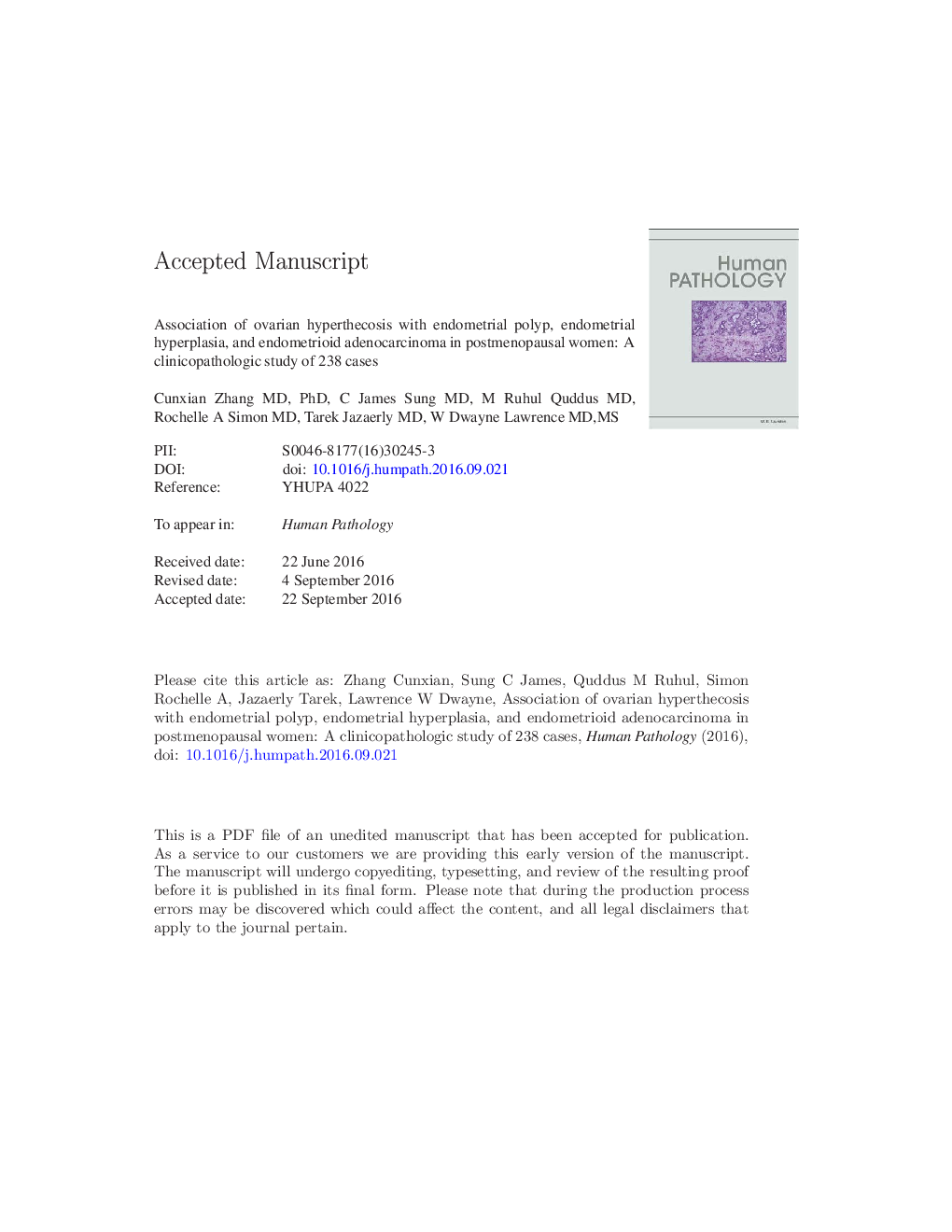| کد مقاله | کد نشریه | سال انتشار | مقاله انگلیسی | نسخه تمام متن |
|---|---|---|---|---|
| 8807806 | 1606651 | 2017 | 22 صفحه PDF | دانلود رایگان |
عنوان انگلیسی مقاله ISI
Association of ovarian hyperthecosis with endometrial polyp, endometrial hyperplasia, and endometrioid adenocarcinoma in postmenopausal women: a clinicopathological study of 238 cases
ترجمه فارسی عنوان
انجمن هیپرترکتوز تخمدان با پولیپ آندومتر، هیپرپلازی اندومتر و آدنوکارسینوم آندومتریوئید در زنان یائسه: یک مطالعه کلینیکوپاتولوژیک 238 مورد
دانلود مقاله + سفارش ترجمه
دانلود مقاله ISI انگلیسی
رایگان برای ایرانیان
کلمات کلیدی
هیپرترکوز تخمدان، پولیپ آندومتر، هیپرپلازی اندومتر، آدنوکارسینوم آندومتریوز، پس از یائسگی،
ترجمه چکیده
هیپرتروئید تخمدانی، منبع استروژن، ممکن است در زنان یائسه ایجاد شود. در این مطالعه، ارتباط هیپرتروئیدی تخمدان با پولیپ آندومتر، هیپرپلازی اندومتر و آدنوکارسینوم آندومتریوئید در زنان یائسه بررسی شد. مطالعه ما شامل 238 زن یائسه بود: 108 نفر مبتلا به آدنوکارسینوم آندومتریوئید و 130 نفر بدون کارسینوم آندومتر. فدراسیون بین المللی زنان و زایمان برای سنجش آدنوکارسینوم آندومتریوئید استفاده شد. در بیماران مبتلا به آدنوکارسینوم آندومتریوئید 48 نفر (44.4٪) درجه 1، 46 نفر (42.6٪) دارای درجه 2 و 14 نفر (13.0٪) دارای درجه 3 بودند. در میان موارد غیرانسانی، 71 نفر (6/54٪) اندومتری آتروفیک، 32 نفر 24/26 درصد) پولیپ آندومتر داشتند و 27 نفر (8/20 درصد) دارای هیپرپلازی اندومتری بودند. فراوانی هیپرترکتوز تخمدان در بیماران مبتلا به پولیپ آندومتر (9/46٪)، هیپرپلازی اندومتر (6/55٪)، و درجه 1 (43/8٪)، درجه 2 (3/54٪) و درجه 3 (1/57٪) آدنوکارسینوم آندومتریو از آن در بیماران مبتلا به اندومتری آتروفیک (9/23 درصد)، حمایت از این ضایعات با هیپرترکتوز تخمدان در زنان بعد از یائسگی. اختلاف آماری معنی داری در میزان هیپرترکتوز تخمدان در بیماران مبتلا به پولیپ آندومتر، هیپرپلازی اندومتر و درجه 1، 2 و 3 در رده آدنوکارسینوم آندومتریوز وجود نداشت. مطالعه ما نشان می دهد که هیترکتوز تخمدان با عامل خطر بالقوه ای از هیپرسترینیسم ممکن است به پاتوژنز پولیپ آندومتر، هیپرپلازی اندومتر و آدنوکارسینوم آندومتریوز در زنان یائسه منجر شود. اگرچه برخی مطالعات نشان می دهد که آدنوکارسینومای اندومتریویید 3 دارای تغییرات ژنتیکی / مولکولی متفاوت از همتایان پایین تر خود است، اما مطالعه ما نشان می دهد که آدنوکارسینوم آندومتریوز در همه رده ها ممکن است عامل خطر مشترک هیدروسترینیسم باشد.
موضوعات مرتبط
علوم پزشکی و سلامت
پزشکی و دندانپزشکی
آسیبشناسی و فناوری پزشکی
چکیده انگلیسی
Ovarian hyperthecosis, a source of estrogen, may occur in postmenopausal women. In this study, we evaluated the possible association of ovarian hyperthecosis with endometrial polyp, endometrial hyperplasia, and endometrioid adenocarcinoma in postmenopausal women. Our study consisted of 238 postmenopausal women: 108 with endometrioid adenocarcinoma and 130 without endometrial carcinoma. The International Federation of Gynecology and Obstetrics system was used to grade endometrioid adenocarcinoma. Within the endometrioid adenocarcinoma cases, 48 (44.4%) were grade 1, 46 (42.6%) were grade 2, and 14 (13.0%) were grade 3. Among the noncancer cases, 71 (54.6%) had atrophic endometrium, 32 (24.6%) had endometrial polyp, and 27 (20.8%) had endometrial hyperplasia. The frequency of ovarian hyperthecosis in patients with endometrial polyp (46.9%), endometrial hyperplasia (55.6%), and grade 1 (43.8%), grade 2 (54.3%), and grade 3 (57.1%) endometrioid adenocarcinoma was each significantly higher than that in patients with atrophic endometrium (23.9%), supporting an association of these lesions with ovarian hyperthecosis in postmenopausal women. There was no statistically significant difference in the rate of ovarian hyperthecosis among patients with endometrial polyp, endometrial hyperplasia, and grade 1, grade 2, and grade 3 endometrioid adenocarcinoma. Our study indicates that ovarian hyperthecosis with its resultant risk factor of hyperestrinism may contribute to the pathogenesis of endometrial polyp, endometrial hyperplasia, and endometrioid adenocarcinoma in postmenopausal women. Although some studies show that grade 3 endometrioid adenocarcinoma has different genetic/molecular changes from its lower-grade counterparts, our study suggests that endometrioid adenocarcinoma of all grades may share the common risk factor of hyperestrinism.
ناشر
Database: Elsevier - ScienceDirect (ساینس دایرکت)
Journal: Human Pathology - Volume 59, January 2017, Pages 120-124
Journal: Human Pathology - Volume 59, January 2017, Pages 120-124
نویسندگان
Cunxian MD, PhD, C. James MD, M. Ruhul MD, Rochelle A. MD, Tarek MD, W. Dwayne MD,MS,
